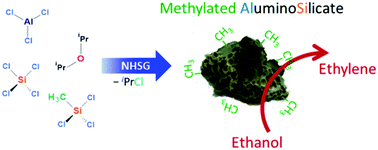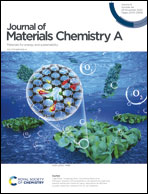Hybrid mesoporous aluminosilicate catalysts obtained by non-hydrolytic sol–gel for ethanol dehydration†
Abstract
Ethanol dehydration is effectively catalyzed by solid acids, such as HZSM-5, alumina, or silica–alumina. In these catalysts, the amount, nature, and strength of acid sites is believed to determine catalyst activity and stability. However, surface hydrophilicity or hydrophobicity can be suggested as another decisive materials property that can directly influence performance. For example, a more hydrophobic surface might be beneficial in repelling the co-product of the reaction, water. However, these aspects have been studied only scarcely in the context of alcohol dehydration. Here, a series of mesoporous hybrid aluminosilicate materials containing CH3Si groups was prepared in one pot by non-hydrolytic sol–gel (NHSG). The presence of the methyl groups was verified by IR, solid-state NMR, and ToF-SIMS. Aluminum is mostly incorporated in tetrahedral coordination in the hybrid silica matrix. Two parameters were varied: (i) the aluminum loading (Si : Al ratio) and (ii) the degree of methylation (Si : MeSi ratio). On the one hand, changing the Si : Al ratio had a marked and expected impact on acidity. On the other hand, unexpectedly, the introduction of methyl groups had no clear influence on sample hydrophobicity. Nevertheless, some of the methylated aluminosilicate catalysts markedly outperformed the purely inorganic catalysts and a commercial silica–alumina benchmark. While a direct influence of surface hydrophilicity or hydrophobicity is unlikely, characterization of acidity (IR-pyridine) revealed that the improved performance for hybrid catalysts is correlated with a modification of the acidic properties (higher proportion of Lewis acid sites) caused by the introduction of methyl groups during the sol–gel process. A decisive role of acidity in ethanol dehydration was confirmed by an experiment with delayed addition of the Al precursor in the NHSG synthesis of the hybrid aluminosilicate. This led to a higher Al surface concentration, marked acid sites number increase, and better catalytic performance, even competing with the state of the art HZSM-5 in terms of ethylene yield.



 Please wait while we load your content...
Please wait while we load your content...